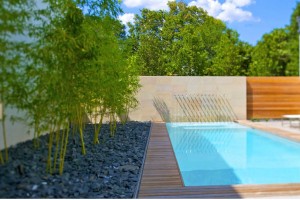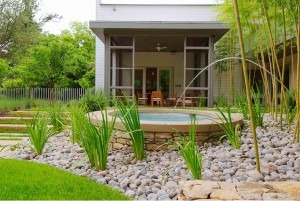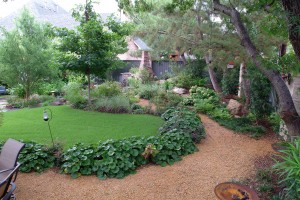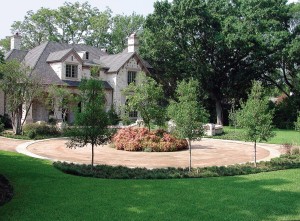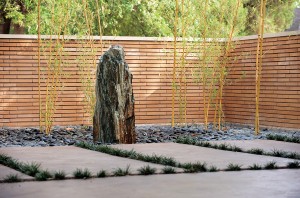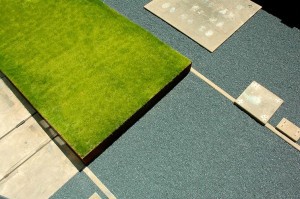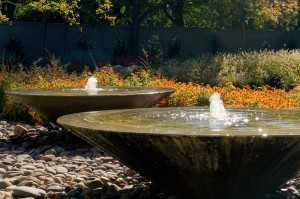
The Glamour of Gravel
Gravel may not seem like the most glamorous of subjects, but you know the old saying, “beauty is in the eye of the beholder” and like most of the landscaping materials I work with, I love and appreciate gravel as a diverse landscaping solution with its own unique features and benefits. There is a lot more to gravel than the drab grey stuff that probably popped immediately into your head at the mention of the word. Many types of rocks are crushed and used for gravel and like flagstone, come in an array of colors from Black Basalt to Pennsylvania Bluestone.
Benefits and Uses of Gravel
Gravel telegraphs a more organic feeling and softer mood than most other kinds of paving. It can be casual or formal, traditional or modern, depending on the type chosen and how it is used. Gravel will last a lifetime and provides excellent drainage, allowing water to readily flow through to the dirt underneath.
Here in the Dallas area, a number of communities have ordinances that limit the amount of impermeable surface allowed on a property. So, for example, if you have a large house with a pool and concrete decking on a small urban lot, a gravel driveway and footpaths may be more than just an aesthetic choice. Ordinances aside, in a drought-prone climate such as ours, gravel, because it is permeable, can certainly be considered a more practical and environmentally friendly choice than concrete.
Gravel can be used for driveways, walkways, patios, play areas, for “petscaping” and is a great choice for mulch. It is low-maintenance, relatively inexpensive and attractive. Gravel has long been used in some of the more arid climates of the Southwest in sparsely planted dessert gardens and even as a green, sustainable alternative to lawn. (Since landscaping typically accounts for 20-50% of all residential water use, the savings can be significant.)
A gravel surface will last indefinitely, but it does require some minimal upkeep that includes occasional weeding and every few years, top-dressing of some new gravel.
Types of Gravel
Gravel comes in a variety of colors, shapes, sizes and materials. What you choose will depend on how you are going to use it along with personal preference. Gravel can be rocks that are mined or tumbled with rounded edges (commonly referred to as river rock), or mechanically crushed to make sharp angular edges (crushed rock). Rounded edges are softer underfoot but are more likely to shift because they are smooth. Crushed rock locks together for a more stable surface, which makes it a better choice for driveways and other high traffic areas. (Other types of gravel, such as pea gravel can be used for driveways and function and look beautiful, however, they are created using a mix that includes crushed granite or concrete to make the surface more stable.)
Today there is a huge range of color options in gravel (although you may have to invest some time and energy to discover all your options if you aren’t relying on a professional landscaper since the selection at the mega hardware chains isn’t that great). Mixed gravels contain many shades of color and mixtures with agate and feldspar can almost seem jewel-like. (These are a good choice for smaller projects that will be seen close up.) Some common types of gravel include:
• Crushed Gravel – What you typically think of when you think of gravel. It’s gray and is made up of sharp and irregularly shaped rock fragments, which makes it easy for the rocks to interlock and compact.
• River Rock – Smooth stones that are softer underfoot, provide good drainage and come in a variety of colors, typically grays and browns and typically range in size from 3/8 inch to 6” inches. River rock is often used in flower and garden beds and on walkways for erosion control. (We used river rock in for the fountain beds in two photos featured in this post.)
• Pea Gravel – Pea gravel is simply smaller sized river rocks and are sandy in color. (We used a pea gravel mixture for the circular driveway featured in this post.)
• Lava Rock – Lava rock is lightweight and porous with angular edges, offering good drainage and usually ranging in size from ¾ inch to 1-1/4 inches. It comes in red or black hues. (We use lava rock a lot for fire pits, however, the black is increasingly hard to find.)
• Quartzite – Quartzite is small, like pea gravel, but a brighter, white color.
• Brick Chips – These are crushed, angular fragments of terra cotta brick ranging from ¾ inch to 1-1/4 inches and are typically used for driveways or as mulch.
• Crushed Marble or Granite – Among our favorite materials for walks, patios and drives. Crushed marble comes in varying sizes and a wide array of colors – reds, greens, golds, yellows, blacks – making it highly versatile. It always looks great and works in many different types of settings.
• Decomposed Granite – DG is readily available gravel that comes in ½ inch to fine powder. This is one of the best materials for drives and walks. It is an orange/brown color.
• Limestone – A great material that is also readily available. It comes in a variety of different sizes from, 3/8 inch – fine powder or dust for walks, drive and patios and up to 3-6 inches for use as small rip rap.
Hopefully, as you’ve been reading this post you have also been enjoying the photos that show some examples of how we use gravel to create beautiful and practical outdoor landscape environments. And maybe, just maybe, you’ll agree with me that gravel can be glamorous.
